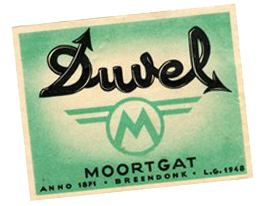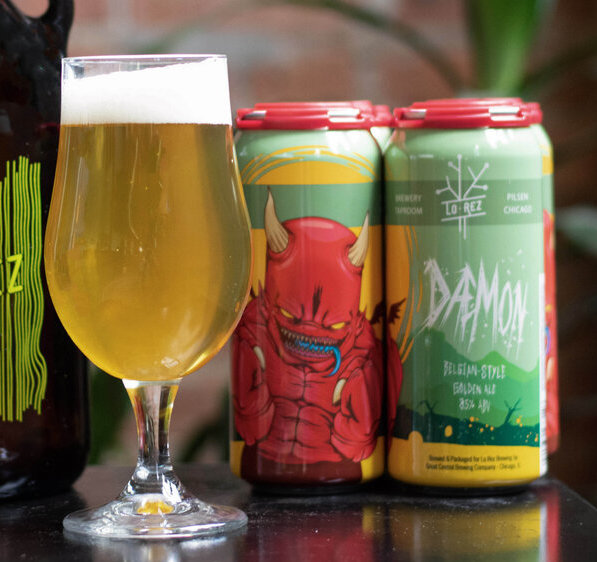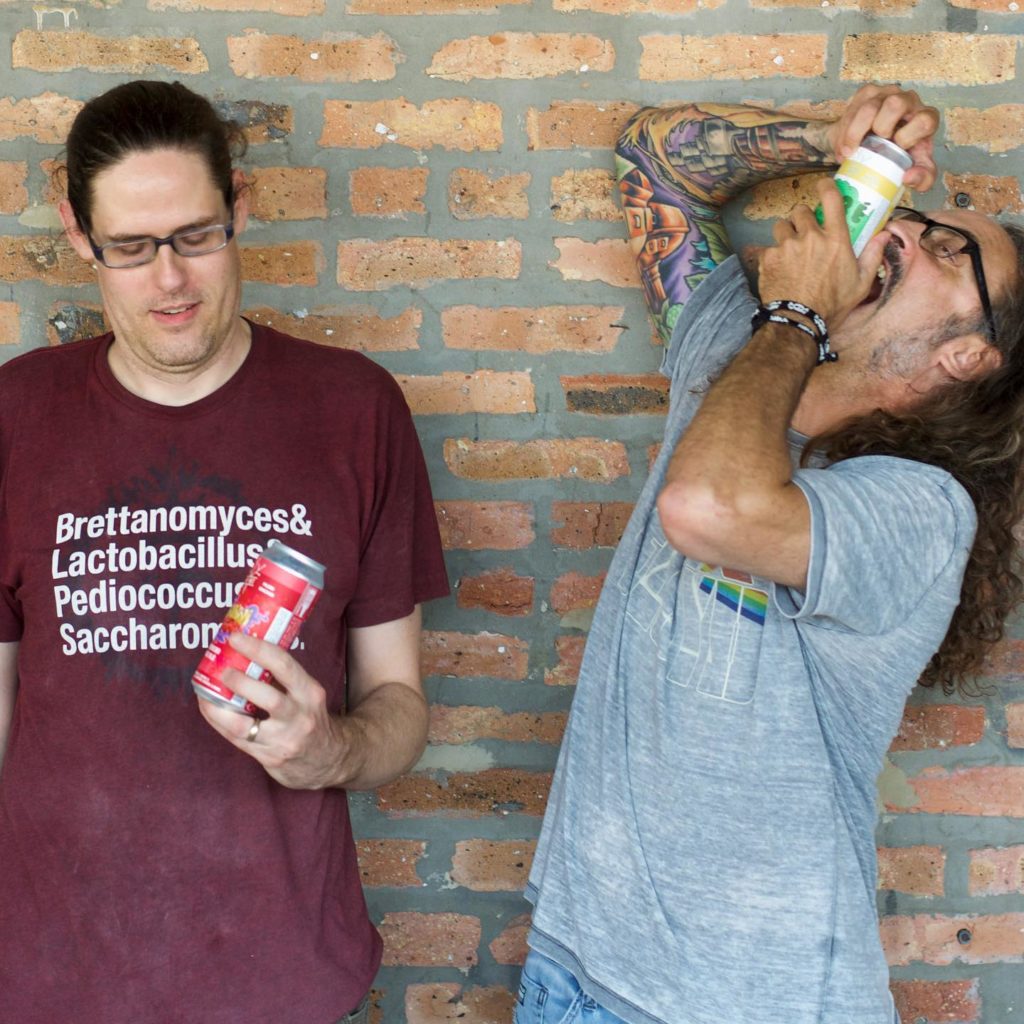Beer Styles Series: Belgian Golden Strong
Monday, June 14th, 2021by Jim Vondracek
One of my favorite beer styles is the Belgian Golden Strong – effervescent, pale, dry, and complex with aromas of fruit, herbs and flowers. If you’ve had Duvel, Piraat, or Delirium Tremens, you know what I’m talking about. This article looks at the colorful history of the style, its parameters and components, brewing it (with a recipe) and ends with a conversation with a commercial brewer, Kevin Lilly, who crafts an excellent US version of the style for Lo Rez Brewing.
History
Duvel became the iconic representation of the Belgian Golden Strong style, originally developed by Brouwerij Moortgat in Breendonck, Belgium. The lore of its genesis revolves around Albert Moortgat obtaining some of the Edinburgh strain of Scottish yeast from McEwan’s or Younger’s breweries. Exactly how Moortgat obtained the yeast remains unclear. Some swashbuckling accounts have him smuggling it out of Scotland in a milk canister. More likely, perhaps, is the more pedestrian version that he propagated it from a bottle of Scottish ale he bought. In any case, Moortgat used Scottish yeast to create the precursor of Duvel, immediately after the end of World War I, called Victory Ale.

Victory Ale had little to do with current day Duvel, except for its strength. It was a dark, flavorful beer. An aficionado referred to it as a ‘real devil’ or duvel in Flemish, and the name stuck, soon being officially re-named Duvel.
The tale takes a dark twist with the German occupation of Belgium, when Albert Moortgat served as mayor of Breendonck. Evidence amassed afterwards points to Albert’s growing embrace of authoritarian ideology. As head of the local government, he served as a leader of the Flemish National Union party. This fascist party welcomed and collaborated with the German occupiers. During that time, Moortgat’s advertising slogan was “One People, One Nation, One Beer”, chillingly echoing the Nazi slogan “One People, One Nation, One Leader”.
Following the liberation of Belgium from the Nazis, Albert was arrested, convicted and served five years in prison for his crimes as a Nazi collaborator. After his release, the family decided having a Nazi at its head was bad marketing. In response, the next generation of Moortgats, Emile and Leon, took over. In the decade following the war, they strengthened the brewery generally. Starting in the 1960s, they changed it forever.
At that time, they partnered with the leading Belgian beer scientist of the era, Jean De Clerck. A university professor, De Clerck authored the highly-influential two-volume tome Textbook for Brewing. Earlier, he created Chimay Blue, the iconic Dark Strong Trappist Ale, at the Abbey of Notre Dame de Scourmont. Now, working with Moortgat, he lightened Duvel’s color, using malts specially kilned for the brand, and dried it out. Most influentially, he isolated strains from the beer’s original Scottish yeast, honing the distinctive herbal and floral aromatics of the style. The result was what we now consider the Belgian Golden Strong style, soon emulated by other breweries.
Style Characteristics
Today, the Golden Strong is an effervescent, complex, pale, dry, strong, fruity and floral ale. An unusual combination of easy-drinkability and high abv, it bears significant similarity to the Trappist Tripel style but with some important differences. Tripels, although dry, often do not end up as dry as the Golden Strong style and possess a somewhat fuller mouthfeel. Most strikingly, the Golden Strong style favors pomme esters – apples and pears – over the phenolic spiciness that partially defines the Tripel.
Hallmarks of the style include both high carbonation and an impressive, long-lasting white head. This effervescence combines with the beer’s dryness and lack of heavy alcohol flavors to make the style remarkably easy-to-drink.
A soft malt aroma and flavor floats through a tasting of the style, supported by a firm but not assertive bitterness.
Floral and herbal aromas also mark the style, lending a sense of delicacy to this style, another surprise from this big, strong and complex beer.
The style finishes dry – a critical component of the style that enhances its easy-drinkability. Some alcohol may be perceived, but nothing harsh, hot or solvent-like.
The Numbers
According to the BJCP style guidelines, the Belgian Golden Strong comes in at:
- Bitterness 22-35 IBUs
- Color 3-6 SRM
- Original Gravity 1.070 – 1.095
- Final Gravity 1.005 – 1.016
- ABV 7.5 – 10.5%
Brewing the Belgian Golden Strong
The challenge in brewing this style lies in making a flavorful, complex, high abv beer that at the same time is dry, easy-to-drink and delicate.
As with many Belgian styles, the use of sugar in brewing helps dry out the beer. Homebrewers often add it to the boil – you’ll read below about the alternative process that Kevin Lilly at Lo Rez uses. The addition of sugar gives the yeast something to eat that they can easily process. This addition adds strength and abv without adding body, sweetness or final gravity points to the finished beer. While Belgian candy sugars may be used, I think that table or cane sugar works well, because you are not looking for any flavors or even color from the sugar addition.
In addition to adding sugar, mashing in low also helps reach the goal of a dry beer. Mashing in the 148 – 150F range activates enzymes which break down the starches and proteins into smaller strands compared to higher mash temperatures. Shorter strands lead to a more fermentable wort which leads to a drier beer. Brewers also sometimes encourage this process by mashing for longer than the standard sixty minutes.
Typically, Pilsner malt makes up most or all of the grain bill for a Golden Strong, lending its typical soft maltiness and breadiness to the beer. Because of the Pilsner-forward grain bill, some brewers will boil for ninety minutes or more to drive off the precursor to DMS, a canned corn off-flavor, which is present at higher levels in Pilsner than in other malts.
Some of the style’s delicateness, floral and herbal aromas come from hops. Noble or English type hops usually make up the hop bill, but an American variety that traces its lineage to Hallertau, such as Mt. Rainier, makes an excellent choice, also.
Yeast selection plays a critical role in this style. While both esters and phenols are present in most Golden Strongs, they tend to emphasize the fruitiness over the spiciness. Some homebrewers purposefully underpitch yeast for Belgian styles, to stress the yeast and encourage the production of esters and phenols. Others think it unnecessary, because Belgian yeasts have been developed over the years to produce significant esters and phenols. Underpitching may lead to other off-flavors and, in the worst case, an under-attenuated beer.
Ramping up the temperature during fermentation is another approach – it both encourages the production of esters and for the yeast to fully attenuate the beer, making the final product more fruity and drier. I often start the fermentation off at 65F with the other ales in our temp controlled ferm room, then will put the fermenter on a heating pad that raises the temp to 70 – 72F, then will move it out of the temp controlled ferm room and let it free rise to 80+F for the final phase of fermentation.
For homebrewers who keg, the Golden Strong may be an excuse to bottle condition – for a change of pace, because it’s traditional, and because carbonation impacts the style so critically. If you can find small champagne bottles, they make ideal bottles for bottle conditioning this style. But in any case, bottle conditioning can add a creaminess to the final beer. In any case, whether you bottle condition or keg, it’s critical that the brewer make their beer effervescent.
Recipe
Grain Bill
- 12.5 lbs Pilsner Malt
- 2.5 lbs Table Sugar
- 1 lb Wheat Malt
- Mash the malts at 148F for sixty minutes, single infusion and batch sparge method
Water Chemistry
- Chicago municipal water
- Add 8 ml lactic acid to the mash
Hops
- 1 oz Mt. Rainer (6% aa) for 60 minutes
- 1 oz Mt. Rainer for 10 minutes
- 1 oz Challenger (8% aa) for 10 minutes
Yeast
- White Labs WLP 570 Belgian Golden Ale or
- Omega OYL-056 Belgian Golden Strong or
- Wyeast 1388 Belgian Strong Ale
- Dry yeast alternatives are Lallemand’s Abbaye Belgian or Fermentis’ Safbrew BE-256 Belgian although the liquid yeast alternatives are preferable for this style
Other
- Whirlfloc or Irish Moss towards the end of the boil
- White Labs Clarity Ferm pitched with the yeast
Numbers
- Batch Size 5.5 gallons
- Brewhouse Efficiency 60%
- Original Gravity 1.075
- Final Gravity 1.004
- ABV 9.3%
- Bitterness 35 IBUs
- Color 4 SRM
Commercial Golden Strong Ale – Lo Rez Brewing’s Daemon
Among the very best US-produced Golden Strong’s I’ve tasted comes from Lo Rez Brewing in Chicago. Thanks to Lo Rez brewer Kevin Lilly for visiting with me about their offering, aptly named Daemon. Daemon is a programming term (meaning a program that runs in the background), a theme Lo Rez uses throughout their lineup. But it also references Duvel – as an archaic spelling of ‘demon’.

Daemon leads the Lo Rez lineup – its flagship beer, in terms of sales. While I found that unexpected, it may not be surprising that a light colored, dry, strong but easy-to-drink and flavorful beer sells well. “It’s super-drinkable like a lager,” according to Lilly, “but it has so much more flavor and aromatics.”
Lilly and his Lo Rez co-founder, Dave Dahl, began brewing the precursor to what became Daemon as homebrewers. Dialing in the yeast character challenged them as they developed the beer. Eventually, they settled on the Ardennes strain, which they still use today. For the homebrewer, that strain is available from White Labs as WLP545 (Belgian Strong Ale) and Wyeast as 3522 (Belgian Ardennes).
To lighten the beer, Lilly adds sugar to the recipe, but not in the boil kettle, which he found occasionally led to a stalled fermentation – the yeast would mow through all the simple sugar and give up. Instead, he adds a sugar syrup to the fermenter, over three days. He begins to add the sugar when the beer’s gravity nears 1 degree plato (about 0.004 brewer’s gravity points) above the target final gravity.
From tasting the beer throughout these final days of fermentation, Lilly found that the yeast created many of the aromatics he seeks after the sugar additions. He finds those aromatics critical and fine-tuned them after working with the Ardennes yeast over and over, learning its subtleties.
He makes the simple syrup in a 50:50 ratio (by weight) of sugar to water, which he never boils but does pasturize at 165F. The only other fermentable he uses is Pilsner malt, with 80% Pilsner to 20% sugar.

Usually, he uses a European malt, depending upon availability. When he can get it, he prefers PIlsner malt from The Swaen, a craft malt house inThe Netherlands.
For hops, he adds Chinook at 60 and 20 minutes, and finishes with a dose of Zuper Saazer (a Michigan variant of the Saaz) at whirlpool.
For Daemon, fermentation starts at 68F and free rises to 75F within 24 hours, and Lilly maintains that temperature until fermentation completes.
I drink Daemon often, and like the best examples of the style, it hides its high abv well and its dry finish enhances its drinkability. It combines complexity and delicateness in a compelling way, with an appealing herbal and floral aroma.







3 Responses to “Beer Styles Series: Belgian Golden Strong”
Great article, Jim! Loved learning about the sordid history of the style and it’s roots.
By Ben R. on Jun 16, 2021
I love this beer style series and would love it if you would do more! I have done a beer in this style with BE-256 and it turned out a little yeasty, with pleasant bannana esters, not overpowering and no phenols, no cloves.
By Patrick Popovich on Jul 14, 2021
Patrick, I’m glad you’re enjoying it, I like writing them and have a couple more in process.
By Jim Vondracek on Jul 19, 2021